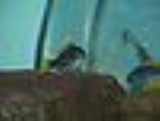
Pseudotropheus acei
Encyclopedia
Pseudotropheus acei is a Mbuna
from Lake Malawi
that grows to around 7 inches in length. There are two different varieties found, the most common Pseudotropheus acei (Msuli), and the white-tail Pseudotropheus acei (Ngara). Like most Mbuna, it dwells in shallower waters, however it will sometimes go near the surface, which is very uncommon for Mbunas. It is a very common fish for fish-keepers
. It gets its common name from its blue body and yellow tail. Originally discovered in 1922 by Regan, the Acei was originally classified as Pseudotropheus
, but was later changed to Gephyrochromis
and then back again. It prefers the sandy and rock filled shoreline where sunken logs are easily accessed. This species has developed the advantage of being able to harvest algae from submerged logs and roots. They are equipped with typical Gephyrochromid cuspid-like teeth that are flat for removing epixlyic or epilithic algae from wood. In the lake, schools of 30-50 individuals surrounding a large log are not uncommon, however in the rocky areas; schools usually consist of 3-10 individuals
s will do. Most vegetable matter will work as well. These fish are possibly the most peaceful fish in the Mbuna family, and because of this it is not necessary a male-female ratio. Their preferred water conditions are a pH of above 7.5 and a temperature of 78–82 °F (26–28 °C).
Mbuna
Mbuna is the common name for a large group of African cichlids from Lake Malawi. The name mbuna means "rockfish" in the language of the Tonga people of Malawi...
from Lake Malawi
Lake Malawi
Lake Malawi , is an African Great Lake and the southernmost lake in the Great Rift Valley system of East Africa. This lake, the third largest in Africa and the eighth largest lake in the world, is located between Malawi, Mozambique, and Tanzania...
that grows to around 7 inches in length. There are two different varieties found, the most common Pseudotropheus acei (Msuli), and the white-tail Pseudotropheus acei (Ngara). Like most Mbuna, it dwells in shallower waters, however it will sometimes go near the surface, which is very uncommon for Mbunas. It is a very common fish for fish-keepers
Fishkeeping
Fishkeeping is a popular hobby concerned with keeping fish in a home aquarium or garden pond. There is also a fishkeeping industry, as a branch of agriculture.-Types of fishkeeping systems:...
. It gets its common name from its blue body and yellow tail. Originally discovered in 1922 by Regan, the Acei was originally classified as Pseudotropheus
Pseudotropheus
Pseudotropheus is a genus of rock dwelling cichlids found in Lake Malawi. Like some other large cichlid genera, such as Cichlasoma, a number of related fishes have been recently re-assigned to different genera such as Tropheops or Maylandia...
, but was later changed to Gephyrochromis
Gephyrochromis
Gephyrochromis is a small genus of cichlid fish. The genus contains two species; Gephyrochromis lawsii and Gephyrochromis moorii, both of which are endemic to Lake Malawi in east Africa.-References:...
and then back again. It prefers the sandy and rock filled shoreline where sunken logs are easily accessed. This species has developed the advantage of being able to harvest algae from submerged logs and roots. They are equipped with typical Gephyrochromid cuspid-like teeth that are flat for removing epixlyic or epilithic algae from wood. In the lake, schools of 30-50 individuals surrounding a large log are not uncommon, however in the rocky areas; schools usually consist of 3-10 individuals
Fish-keeping
These mbunas are omnivorous but prefer plants and algae in their diet. If they are to be fed staple, then any food made for African CichlidCichlid
Cichlids are fishes from the family Cichlidae in the order Perciformes. Cichlids are members of a group known as the Labroidei along with the wrasses , damselfish , and surfperches . This family is both large and diverse. At least 1,300 species have been scientifically described, making it one of...
s will do. Most vegetable matter will work as well. These fish are possibly the most peaceful fish in the Mbuna family, and because of this it is not necessary a male-female ratio. Their preferred water conditions are a pH of above 7.5 and a temperature of 78–82 °F (26–28 °C).

